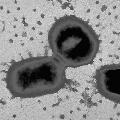



|
| This project is collaborated between The Forsyth Institute (TFI) and The Institute for Genomic Research (TIGR), and is funded by National Institute of Dental and Craniofacial Research (NIDCR) |
|
|
|||||||||||||||||||||||||
Choice of strain for sequencingThere is no evidence for limitation of virulence to particular clonal types or genetic lineages in P. gingivalis. Loos et al., (1993) investigated the genetic diversity of P. gingivalis by multi locus enzyme electrophoresis (MLEE) of 16 metabolic enzymes from 100 human and non-human strains isolated from widespread geographic locations. All enzymes were polymorphic. Cluster analysis placed 78 electrophoretic types into 3 phylogenetic divisions, with all human strains falling into the largest division. Virulence, as assessed in the mouse model, was not limited to any particular electrophoretic type, serotype, or fimbrial RFLP group, but rather virulent and some avirulent strains were distributed across the entire human cluster. The genetic diversity of P. gingivalis isolates was also supported by random amplified polymorphic DNA fingerprinting (Menard and Mouton, 1995). P. gingivalis strain W83 was chosen for study because it is virulent in the mouse model (Neiders, et al., 1989; Genco et al., 1991); has been extensively studied by the P. gingivalis community, including sequencing; and can be manipulated genetically. |
||||
|
This page is created and maintained by Drs. Margaret Duncan, Floyd Dewhirst, and Tsute Chen, Department of Molecular Genetics, The Forsyth Institute . Last modified on 02/20/2002 Copyright 2000, 2001, 2002 by The Forsyth Institute |